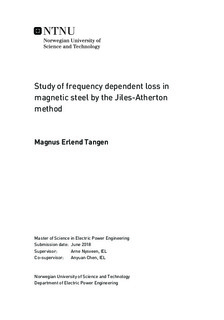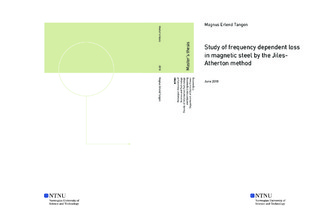| dc.description.abstract | This thesis is a continuation of a specialization project which investigated the possibility of simulating the hysteresis and eddy current losses in carbon steel. The work comprises an investigation of how to efficiently obtain Jiles-Atherton (J-A) parameter values for magnetic materials and thus ease the J-A implementation of new materials in a finite element method (FEM) software for loss simulations. The J-A method is implemented in a FEM model and verified by simulated and measured AC losses. Two different ferromagnetic materials are investigated.
The generic software JAMPS (Jiles-Atherton Parameter Search) was developed and used as the tool for obtaining the J-A parameter values. JAMPS was developed with a graphical user interface (GUI) to increase the usability of the software.
The verification of the J-A parameters was performed in the FEM software Comsol Multiphysics where a model was developed to simulate the measurement equipment used to measure the loss in the material samples. The operation principle of the measuring instrument is investigated and explained to obtain a comparable loss simulation in Comsol. The resulting FEM model is relatively efficient in terms of computation time and result resolution.
The simulations and measurements were performed with the target flux densities 100, 200, 300 and 400mT at the frequencies 50, 100, 150 and 200Hz. The measured AC losses were used as references and compared with the simulated losses from the FEM model. In general, the simulation of the total losses was performed with a low error and the implementation of the J-A method is regarded as a success. The difference between the simulated and measured total losses in material 1 is in the range of -15% to 5%. The difference between the simulated and measured total losses in material 2 is in the range of 0% to 37%,
The comparison of the measured and simulated eddy current and hysteresis loss showed a significant difference between the measured and simulated losses in both materials. The separated losses could not be expressed analytically with a satisfactory low error. This indicates that the difference between the measured and simulated eddy current and hysteresis losses may be due to other reasons than inaccurate material descriptions in the FEM model. | |

